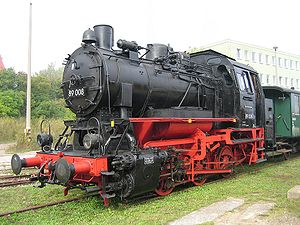DR series 89.0 (1934)
| DR series 89.0 PKP TKh5 |
|
|---|---|
|
89 008 in Schwerin
|
|
| Numbering: | DR 89 001-010 |
| Number: | 10 |
| Manufacturer: | Berliner Maschinenbau AG formerly Louis Schwartzkopff (001–003), Henschel & Sohn (004–010) |
| Year of construction (s): | 1934 (6 pieces) 1938 (4 pieces) |
| Retirement: | 1968 |
| Type : | C n2t (001–003) C h2t (004–010) |
| Genre : | Gt 33.15 |
| Gauge : | 1435 mm ( standard gauge ) |
| Length over buffers: | 9,600 mm |
| Service mass: | 46.6 t |
| Friction mass: | 46.6 t |
| Wheel set mass : | 15.6 t |
| Top speed: | 45 km / h |
| Indexed performance : | 235 kW (wet steam) 385 kW (superheated steam) |
| Starting tractive effort: | ~ 97 kN |
| Driving wheel diameter: | 1,100 mm |
| Number of cylinders: | 2 |
| Cylinder diameter: | 420 mm |
| Piston stroke: | 550 mm |
| Boiler overpressure: | 14 bar |
| Grate area: | 1.42 m² |
| Superheater area : | 24.10 m² |
| Evaporation heating surface: | 67.86 m² |
| Water supply: | 4.5 m³ (wet steam), 4.8 m³ (hot steam) |
| Fuel supply: | 2.6 tons of coal |
| Brake: | automatic single-chamber compressed air brake type Knorr |
The class 89.0 was a freight tender locomotive and a standard locomotive of the Deutsche Reichsbahn . It was the smallest standard locomotive put into service by the Reichsbahn. While the road numbers 89 001-89 003 were supplied as wet steam engines, the remaining seven were superheated steam locomotives . Since there was no longer any Prussian T 8 (89 001 to 078) in the holdings of the Deutsche Reichsbahn, this number range could be used a second time.
history
Initially, three wet steam locomotives (89 001–003) and three superheated steam locomotives (89 004–006) were ordered. One of each was tested in the Grunewald Locomotive Research Office . On the basis of the results, four hot steam locomotives were reordered. No further construction was done because of the Second World War . The locomotives were stationed in the Gesundbrunnen depot and were used at Berlin train stations, especially the Anhalter Bahnhof . In 1944 the 89 001, 004, 006, 007 and 010 came to Deutsch-Lissa in Silesia, where they remained after the war. The Polish state railway PKP called them TKh5. The 002, 003 and 009 were also given to Poland in the late 1940s on the orders of the Soviet military administration. The 89 005 was last stationed in the Leipzig West depot, the 89 008 in the Dresden-Altstadt depot . The Polish locomotives were taken out of service by 1954.
Constructive features
The locomotive was the first German shunting locomotive to use welding technology. She had a steel fire rifle. The water tank was housed under the boiler in the frame, the coal tank on the back of the driver's cab. The third axle was driven.
Whereabouts
The last example of this series, locomotive 89 008, was decommissioned in 1968 in the Dresden-Altstadt depot and was retained as a traditional locomotive for the Dresden Transport Museum. The machine has been owned by the Mecklenburg Railway Friends in Schwerin since 1992.
Others
The model of an 89 2004 model of the German Federal Railroad in nominal size Z , produced by Märklin since 1972, was listed by the Guinness Book of Records as the smallest series model railway locomotive until 2007. This model is only the shape of an 89.0. In reality there was never an 89 in 2004 and neither did this series run on the DB.
literature
- Horst J. Obermayer: Paperback German steam locomotives - standard gauge . Franckh'sche Verlagshandlung, Stuttgart 1969, ISBN 3-440-05530-2 .
